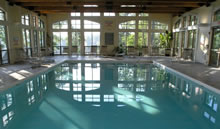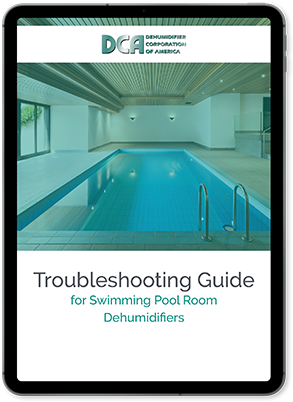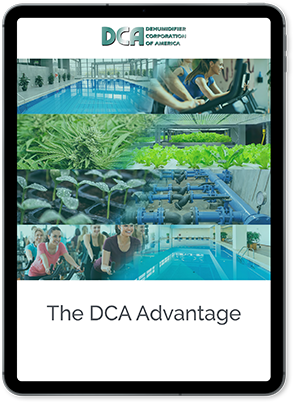Proper humidity levels are essential for maintaining optimal air quality in a grow room, but efficiently monitoring and managing these levels can be challenging.
Monitoring and managing indoor humidity levels can be challenging in any type of space, but indoor pool rooms present unique difficulties. Without careful attention and management, imbalanced room air temperature and pool water temperature relationships in these rooms can cause corrosion, condensation, mold, mildew and poor air quality affecting swimmers comfort and building integrity.
In commercial indoor pool rooms, trained employees are typically on hand to manage dehumidification processes, temperature monitoring, and pool water chemistry. However, residential pool rooms usually can’t rely on employees for upkeep, nor can most semi-commercial spaces in hotels and condos; service technicians are available, but their vists are usually infrequent.
Partnering with knowledgeable HVAC professionals — ones that can provide useful feedback, recommend reliable technology, and suggest customized management plans for monitoring and controlling humidity levels — can allow for significant time and cost savings.
At the Dehumidifier Corporation of America (DCA), our engineers frequently come across pool room dehumidification systems that have not been consistently or effectively maintained.
High turnover is common among pool room maintenance personnel — particularly in hotels, motels, and other hospitality-industry facilities — but to ensure optimal safety, performance, and longevity, it’s essential to establish a comprehensive dehumidification system maintenance plan that adheres to manufacturer recommendations.
In order to remain functional, comfortable, and safe, swimming pool areas must be equipped with high-quality, reliable dehumidification systems. As with any complex system, pool room dehumidification equipment requires regular maintenance and, periodically, replacement.
Determining whether replacement is the appropriate action, however, can be daunting or confusing, as diagnosing problems is often a complex process in itself. And once system issues have been identified, an operator must determine which course of action will best rectify them: repair, retrofit, or complete replacement.
Although dehumidifiers are built to endure harsh environments, the average lifespan of a dehumidifier used for industrial and institutional applications is nine to eleven years. It is typically more expensive to keep an aging unit instead of simply replacing the dehumidifier altogether.
At Dehumidifier Corporation of America, we can easily replace an obsolete dehumidifier. With the help of our team of experts, we can help you choose the exact replacement dehumidifier you’re looking for based on your requirements.
Vertical farming is an agricultural method in which crops such as leafy greens and herbs are farmed indoors within climate-controlled environments. As the process becomes more efficient and economically viable, these urban farms are becoming more prevalent across the United States.
By controlling important environmental factors indoors, growers are able to cultivate better-quality crops at higher yields and in shorter periods of time. This also reduces the human footprint on the environment, as water and nutrients are conserved and less pollution and emissions are generated.
Whether using dehumidification for industrial, commercial, residential, or swimming pool applications, customers must determine, if applicable, which of the two typical cooling system options will be the best fit for their application — air cooled or water cooled.

Air cooled dehumidifiers, for indoor pool room dehumidification and other projects, are the most common type and deliver warm dry air back to the space when operating. When room cooling is needed they are coupled with an optional outdoor remote condenser. This allows them to deliver warm dry air or cool dry air depending on what the controls call for.
Humidity is a major concern for all indoor swimming pool owners. Air-to-air heat exchangers and ventilation systems were commonly used to control pool room humidity.
 These methods are expensive to operate and wasteful, in that they constantly exhaust previously heated or cooled air outdoors. They also often fail to prevent structural damage caused by excess moisture, as the formation of mold and mildew in cold walls can cause irreparable damage.
These methods are expensive to operate and wasteful, in that they constantly exhaust previously heated or cooled air outdoors. They also often fail to prevent structural damage caused by excess moisture, as the formation of mold and mildew in cold walls can cause irreparable damage.
The most effective way to control pool room humidity is to use a full dehumidification system that serves to remove destructive moisture and add room heating as a by-product of the dehumidification cycle.
Hotel, motel, and residential indoor pool rooms are just a few scenarios where you can find dehumidification systems controlling the relative humidity. An unexpected failure of a dehumidification system in these facilities can have some considerable negative impacts.
 A malfunctioning dehumidification system can cause mold and mildew build up quickly. This can lead to musty smells and poor air quality, not to mention structural issues.
A malfunctioning dehumidification system can cause mold and mildew build up quickly. This can lead to musty smells and poor air quality, not to mention structural issues.
Malfunctioning dehumidification systems can also lead to unhappy customers and bad reviews, which could hurt a business. In an industrial setting, a manufacturer can lose a large amount of money in downtime, missed deadlines, or ruined product when relative humidity is out of control.
Dehumidifier Corporation of America (DCA) designs dehumidification systems for a wide range of applications. We have provided dehumidification solutions to hotel and motel chains, homeowners and manufacturing facilities where the control of relative humidity is critical. No matter what kind of building you operate, summer humidity can pose a real problem. High humidity is a particular threat for facilities that store sensitive items that can be ruined by moisture, like food or powdered products that take on moisture.



